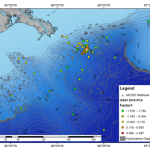I have to say, I’m pretty impressed with NOAA.
If you’ve been to their homepage lately, you’ll notice that the key Deepwater Horizon links have been inserted into a nice little banner across the top of the site. The historic archive! Restoration Projects! Seafood Safety!
I’d like to think that Deep-sea News had something to do with the great website redesign for Seafood Safety [Dr. Bik polishes fingernails on shirt]. I had spoken with a NOAA press officer a while back and expressed my concerns about the labyrinth of links and too-technical releases of information. She e-mailed me back and said they were working on it. And now, lo and behold! The Seafood Safety homepage looks like a blog post links roundup. There are great visual maps of the testing sites. The data for polycyclic aromatic hydrocarbons (PAHs) and dispersant compound dioctyl sodium sulfosuccinate (DOSS) are available as full, technical datasheets AND easy-to-understand summary tables that list the level of concern versus actual levels found in tested samples. I am very, very impressed. Its also good to know that NOAA is still diligently testing the seafood, nearly a year after the well was capped.
You also may have heard about restoration projects in the Gulf of Mexico – if you signed up to the e-mail lists (like me), you’re getting battered by an ongoing stream of public meeting announcements. However, the term “public meeting” might be a bit misleading…
Perception of the American public: “The Government wants to fund OUR project ideas! Wow, that is democracy in action, baby!”
View of government agency staff: “People need to be reassured and keep abreast of what’s going on. Plus, we can use their concerns to justify the restoration programs we’ve already thought up.”
Maybe I’m already becoming a cynical academic at my tender young age. Now, I’m not saying this situation is a BAD thing. That’s like me walking into the New York Stock Exchange, yelling out “INVEST IN THE INTERNET!!” and expecting all the seasoned Wall Street traders to lurch into a internet-stock-buying panic. I don’t know the complexities and nuances of the market. Likewise, the legal process and restoration progress in the Gulf of Mexico is VERY complex.
That being said, from my conversations with colleagues in Gulf research institutes, university scientists are often left out of this process as well. We’ve learned not to get our hopes up.
That’s enough ranting for me. I’m going back to working on our 20-PI consortium grant for the Gulf of Mexico Research Initiative ($500 million in BP money that is being distributed for long-term scientific research in the Gulf). This proposal is a behemoth. Our e-mail list has 47 people on it.
If your’e interested in learning about the proposed projects, you can read about all 111 of them. Submission deadline is July 12th, and then I’ll be sure to post another update when we know what gets funded. Fingers crossed!






A major criticism is that projects are being selected with no input or transparency from the public. Louisiana has almost 400 projects for early restoration alone. so the fact that the NOAA site only has 11 projects sends a chilling message. all the projects are still up on the louisiana site, but why only 111 on NOAA’s?